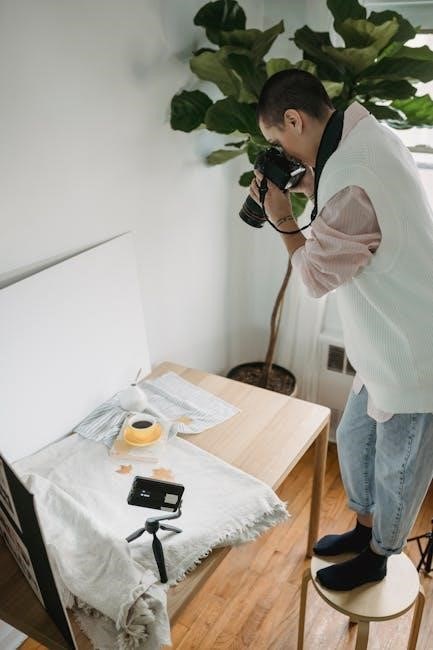
Overview of the Lorex LNB9252B Bullet Camera
The Lorex LNB9252B is a 4K Ultra HD bullet camera offering real-time 30 FPS recording, excellent night vision, and smart motion detection. Built with a durable metal exterior, it is weather-resistant and features Power over Ethernet (PoE) for easy installation. Part of Lorex’s Nocturnal 3.0 series, it provides enhanced surveillance for both home and business use.
1.1 Key Features and Specifications
The Lorex LNB9252B bullet camera boasts 4K Ultra HD resolution, capturing crisp video at 30 FPS. It features advanced night vision up to 150 feet, ensuring clear surveillance in low-light conditions. Equipped with smart motion detection, it delivers accurate alerts by distinguishing between people, vehicles, and other objects. The camera includes listen-in audio capabilities for real-time sound monitoring. Built with a durable metal exterior, it is weather-resistant and designed for outdoor use. It supports Power over Ethernet (PoE) for seamless power and data transmission via a single cable. With an 8MP image sensor, it provides high-quality video recording and is compatible with the Lorex Home app for remote monitoring and setup.
1.2 Compatibility and Requirements
The Lorex LNB9252B is designed to work seamlessly with compatible Lorex NVRs and PoE switches, ensuring a robust security system. It requires a stable internet connection for remote access via the Lorex Home app. The camera is compatible with the Lorex Home app, enabling easy setup and management. For optimal performance, it should be connected to a PoE switch or compatible NVR. The camera supports Cat5e Ethernet cables for power and data transmission. It is weather-resistant and suitable for outdoor installation, operating in various environmental conditions. Ensure proper installation by following the mounting guidelines, such as placing it 8-16 feet off the ground for optimal coverage. Regular firmware updates are recommended to maintain functionality and security.

Lorex LNB9252B Bullet Camera Setup Process
The setup involves mounting the camera, connecting it to a PoE switch or NVR, and configuring network settings. Use the Lorex Home app for final configuration.
2.1 Physical Installation: Mounting and Wiring
Mount the Lorex LNB9252B camera in a sheltered outdoor location, 8-16 feet off the ground, using the provided mounting template for accurate placement. Ensure the camera is level and securely fastened with screws. Connect the Ethernet cable to the camera and the other end to a PoE switch or NVR. Twist the RJ45 cable gland securely to prevent weather interference. Tighten the camera angle after installation for optimal coverage. The camera’s weather-resistant design ensures durability in outdoor conditions. Proper wiring ensures power and video transmission via a single Ethernet cable, simplifying the setup process.
2.2 Network Connection: Pairing with PoE Switch or NVR
Connect the Lorex LNB9252B camera to a PoE switch or compatible NVR using the Ethernet cable. Ensure the NVR and camera are on the same network. Power the camera via the PoE switch or NVR, and wait for automatic detection. If not detected, manually search for the camera in the NVR interface. Once connected, configure settings like motion detection zones and video quality via the Lorex Home app or NVR menu. Verify the video feed and night vision functionality. For troubleshooting, check the Ethernet connection, restart the camera, or reset it if necessary. Proper network pairing ensures seamless performance and remote access to live footage.

Lorex Home App Setup and Configuration
Install the Lorex Home app, create an account, and add the camera via WPS or manual pairing. Configure settings like motion detection and alerts for optimal performance.
3.1 Downloading and Installing the Lorex Home App
To begin, download the Lorex Home app from the App Store (iOS) or Google Play Store (Android). Once installed, launch the app and create a Lorex account or log in if you already have one. Ensure your smartphone is connected to the same network as your Lorex NVR or PoE switch. Connect the Lorex LNB9252B camera to the NVR or PoE switch using an Ethernet cable. Open the app, tap the “+” icon to add a device, and scan the QR code on the NVR or enter the device’s serial number manually. Follow the in-app instructions to complete the setup and configure settings like motion detection and alerts.
3.2 Adding the Camera to the Network via WPS
To connect the Lorex LNB9252B camera to your network using WPS, open the Lorex Home app and navigate to the “Add Device” section. Select the WPS option and press the WPS button on your router. The camera will automatically detect and connect to the network. Once connected, the app will confirm the link, allowing you to view the camera feed and configure settings like motion detection and alerts. Ensure the router supports WPS and both devices are on the same network for a smooth setup. If issues arise, restart the router or consult the Lorex support guide for troubleshooting.
Configuring Camera Settings for Optimal Performance
Adjust motion detection zones and sensitivity to minimize false alerts. Fine-tune video quality, night vision, and audio settings via the Lorex Home app for enhanced monitoring.
4.1 Adjusting Motion Detection Zones and Alerts
To optimize motion detection, access the Lorex Home app and navigate to the camera settings. Define custom motion zones by selecting areas of interest within the video feed. Adjust sensitivity levels to reduce false alerts, such as ignoring minor movements like pets or trees. Enable alerts for specific zones and set notification preferences, including push notifications or email updates. Schedule alert times to avoid unwanted triggers during known activity periods. Test the settings to ensure accurate detection and refine as needed. Regularly review alert logs to analyze patterns and further tweak zones for improved accuracy. This ensures reliable monitoring and minimizes unnecessary notifications.
Troubleshooting Common Setup Issues
Common issues include no video feed, connectivity problems, or pixelated images. Check Ethernet connections, ensure proper power supply, and verify network settings. Resetting the camera or updating firmware often resolves these problems.
5.1 Resolving Connectivity and Video Feed Problems
Connectivity issues with the Lorex LNB9252B often arise from faulty Ethernet connections or incorrect network configurations. Ensure the Ethernet cable is securely connected to both the camera and the PoE switch or NVR. If the camera fails to power on, check the PoE switch or NVR for proper functionality. For video feed problems, verify that the camera is detected by the NVR or Lorex Home app. If the feed is pixelated or blurry, adjust the camera’s focus or ensure it is placed in an area with optimal lighting. Night vision issues may occur due to infrared LED blockage; clean the lens and ensure no obstructions are present. Restarting the camera or performing a factory reset can often resolve persistent issues.

Regular Maintenance and Firmware Updates
Regularly clean the camera lens and inspect wiring to ensure optimal performance. Update firmware via the Lorex Home app or NVR for enhanced functionality and security.
6.1 Updating Firmware for Enhanced Functionality
To ensure your Lorex LNB9252B camera performs at its best, regular firmware updates are essential. These updates improve functionality, fix issues, and add new features. Steps to update:
Open the Lorex Home app or access the NVR settings menu.
Check if a firmware update is available for your camera.
Ensure the camera is online and connected to the PoE switch or NVR.
Backup important recordings before proceeding.
Follow the in-app or NVR instructions to download and install the update.
Allow the camera to reboot during the process.
After the update, verify the firmware version and test the camera’s performance. Avoid power outages during updates to prevent issues. Regular updates ensure optimal security and functionality.

6.2 Cleaning and Maintaining the Camera
Regular maintenance ensures the Lorex LNB9252B camera functions optimally. Cleaning the lens: Use a soft, dry microfiber cloth to wipe away dirt or smudges. Avoid harsh chemicals or abrasive materials, as they may damage the lens. For stubborn spots, lightly dampen the cloth with distilled water.
Checking wiring: Inspect Ethernet cables for damage or loose connections. Secure all connections to prevent signal loss.
Clearing debris: Remove dirt, leaves, or snow from the camera housing to ensure unobstructed views.
Scheduling maintenance: Perform these tasks every 2-3 months or after extreme weather conditions. Proper care extends the camera’s lifespan and ensures clear video quality.